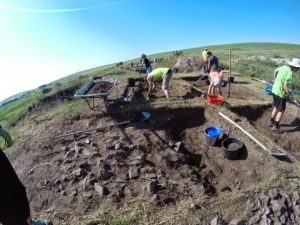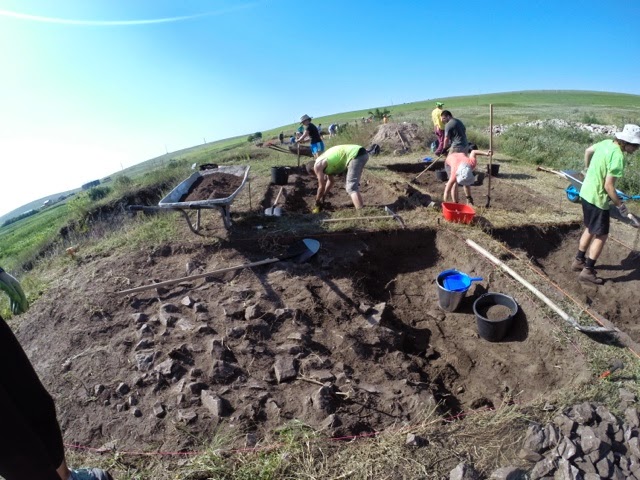
It is an archaeological site, but one needs some imagination to picture an ancient Roman fort abutting a major waterway at this place.
“When you first enter the site you are on a very small hill, about three meters at the most above the surrounding farmland to the north and east,” writes blogger Lucy MacDonald, who spent part of her summer as a volunteer excavator at the site. It is known as the location of ancient Halmyris, a Roman frontier stronghold in present-day Romania. “Those farm fields used to be the Danube river; however, the river has receded about 300 meters from where it used to be. We know this because there are two man-made harbours at Halmyris, therefore the Danube would have come right up to the fort. The fort had approximately twelve towers, and with good reason. The location of Halmyris is important because it intersects two important commercial shipping waters, the Danube and the Black Sea. However, this also made it a target for Roman enemies—which was EVERYONE.”*
In a real sense, the site of Halmyris tells a story of an empire under siege from enemies without—and as anyone with a knowledge of classical history knows, Rome had many enemies. Strategically located Halmyris, at its fortified height, was a target for Germanic tribes, Goths, and Huns, to name a few of the most prominent. Halmyris, however, was also more anciently a point of trade and contact between the more indigenous inhabitants of the region and colonizing, merchant Greeks. Much later, it was also a Byzantine fortification and settlement. But Halmyris is perhaps best known by visitors and pilgrims alike as a place of martyrdom. In 290 CE, two Christian missionaries, Astion and Epictet, were imprisoned, tortured, and executed by the Romans here. They were later reburied under orders of the emperor Constantine I (c 324/325) in a crypt under the altar of a newly built basilica within the fort. The Church later canonized them, and today pilgrims of the Romanian Orthodox Church visit a nearby monastery built in honor of the saints. “Dirt delivered by the river eventually spread over the site, until only the jagged tops of the towers and walls were visible to those wandering the hills south of the Danube,” reports the Halmyris excavation project at its project website. “Hundreds of years later, locals would tell stories about the treasure hidden inside the mysterious walls, and of the spirits that guarded the site. These stories were perhaps vindicated, when Professor M. Zahariade [currently with the Vasile Parvan Institute of Archaeology, Bucharest] later discovered the remains of the Christian martyrs in a hidden crypt within Halmyris.”**
Today, Zahariade is meticulously recovering and researching the remains of Halmyris with the help of a team of scholars, archaeologists, students and volunteers. To date, they have uncovered a significant amount of new edifices and artifacts, including features of the ancient harbor located below the walls of the fort, a structure adjacent to the walls, a 6th century defensive tower, other well-preserved architectural features and numerous small finds including coins, weaponry, and ceramics indicating intense activity related to Roman occupation.
_________________________________
 Above, excavators hard at work at Halmyris. Photo credit Lucy MacDonald from her blog, Istanbul not Constantinople.
Above, excavators hard at work at Halmyris. Photo credit Lucy MacDonald from her blog, Istanbul not Constantinople.
___________________________________
“For the field season of 2015, we hope to concentrate efforts in multiple areas of the site, including the monumental entrance-way, the northeastern wall, two defensive towers/bastions and, last but not least, on areas of the urban (civilian) center,” reports project management. “We also intend to begin work on an especially large structure (as revealed by a GPR survey) near the western gate. This will undoubtedly be a season of particular significance and proliferation of finds, as the nearby areas have proven especially rich in archaeological material.”**
More information about the Halmyris project can be obtained at the website. In addition, one can read the personal account of dig volunteer Lucy MacDonald at her blog site.
_______________________________________________
* http://instanbulnotconstantinoople.blogspot.co.uk/2014/07/romans-in-romania.html
** http://www.halmyris.org/
Cover Photo, Top Left: Excavators hard at work at Halmyris. Photo credit Lucy MacDonald
_______________________________________________
Travel and learn with Far Horizons.
______________________________________
Read about the most fascinating discoveries with a premium subscription to Popular Archaeology Magazine. Find out what Popular Archaeology Magazine is all about. AND MORE:
On the go? Get the smartphone version of Popular Archaeology as an app or as an ebook.
Popular Archaeology’s annual Discovery Edition eBook is a selection of the best stories published in Popular Archaeology Magazine in past issues, with an emphasis on some of the most significant, groundbreaking, or fascinating discoveries in the fields of archaeology and paleoanthropology and related fields. At least some of the articles have been updated or revised specifically for the Discovery edition. We can confidently say that there is no other single issue of an archaeology-related magazine, paper print or online, that contains as much major feature article content as this one. The latest issue, volume 2, has just been released. Go to the Discovery edition page for more information.






